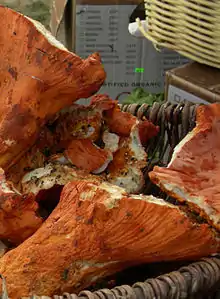Hypomyces
Hypomyces is a genus of parasitic ascomycete fungi found in Europe, North America, Australia, and parts of China. The genus contains 53 species.[1] Better known species include the lobster mushroom (Hypomyces lactifluorum) and the bolete eater (Hypomyces chrysospermus).
| Hypomyces | |
|---|---|
 | |
| H. lactifluorum | |
| Scientific classification | |
| Kingdom: | |
| Division: | |
| Class: | |
| Order: | |
| Family: | |
| Genus: | Hypomyces |
| Type species | |
| Hypomyces lactifluorum (Schwein.) Tul. & C. Tul. | |
List of noteworthy species
- H. cervinigenus - on Helvella lacunosa.[2]
- H. chrysospermus - Bolete Eater, Cask fungus (Eurasia, Western Australia, North America)
- H. hyalinus - Amanita "mold" (North America)
- H. lactifluorum - Lobster mushroom (North America)
- H. luteovirens - Yellow-green Russula "mold" (North America)
- H. transformans - Ramaria Eater (North America)
Ecology and Shape
All Hypomyces species live by infesting other fungi. The hypomyce fungi itself is not very conspicuous, and generally presents as a scab of only 1 mm in diameter and height. In many cases, this fruiting body grows on the fruiting body of another fungus that has become the host, and changes the form and color of the host to something different from the original.
The individual fungi bodies are finely grained, and many of them exhibit long, narrow ellipsoids under magnification. Their diameter and height are usually about 1 to 2 mm. In general, hyphae are spread on the surface of a host fruit body and buried in the mycelium to form a large number of fruiting bodies. These can be yellow, white, olive, tan, pink or red, and present within the host or in the hypha mat.
Within the individual Ascomycete fungi, spore sacs known as asci are formed. Asci have an elongated cylindrical shape, and has a dome-shaped structure called a “cap” at the tip. Ascospores are formed, then ejected from the tip of the fruit body to the outside world.
Spores generally have a slightly angular ellipsoid shape, and in many species they are separated by a single partition, usually exhibiting a colorless to pale yellow color, and the cell walls are thick with warts or humps on the surface.
Life Cycle
Most species reproduce asexually. Asexual regeneration spores are generally called thick-wall spores, as they have thick cell walls. Unfortunately, the precise mechanisms of spore reproduction, specifically the methods used to find and infest hosts is largely unknown.
Host
The fungi generally prefers terrestrial mushrooms such as the genus Amanita, Agaricus genus, Chichitake genus, Numeriiguchi genus and Awotake genus.
If the host is a wood ear mushroom, the fungi produces a colloidal fruiting body
Many agaric mushrooms, when used as a host, do not develop properly and become malformed
Distribution
Species of Hypomyces have been found in Europe, North America, Australia, and parts of China. There are at least 19 species recorded in Japan.
Other Species
- Hypomyces agaricola
- Hypomyces albidus
- Hypomyces albus
- Hypomyces amaurodermatis
- Hypomyces apiculatus
- Hypomyces apiosporus
- Hypomyces arachnoideus
- Hypomyces arecae
- Hypomyces arenaceus
- Hypomyces armeniacus
- Hypomyces asclepiadis
- Hypomyces ater
- Hypomyces aurantiicolor
- Hypomyces aurantius
- Hypomyces auriculariicola
- Hypomyces australbidus
- Hypomyces australiensis
- Hypomyces australis
- Hypomyces badius
- Hypomyces banningiae
- Hypomyces batavus
- Hypomyces biasolettianus
- Hypomyces boleticola
- Hypomyces boletinus
- Hypomyces boletiphagus
- Hypomyces bombacinus
- Hypomyces bresadolae
- Hypomyces bresadolanus
- Hypomyces camphorati
- Hypomyces caulicola
- Hypomyces cervinigenus
- Hypomyces cervinus
- Hypomyces cesatii
- Hypomyces chlorinigenus
- Hypomyces chlorinus
- Hypomyces chromaticus
- Hypomyces chrysospermus
- Hypomyces completus
- Hypomyces conviva
- Hypomyces corticiicola
- Hypomyces dactylarioides
- Hypomyces deformans
- Hypomyces destruens-equi
- Hypomyces ekmanii
- Hypomyces epimyces
- Hypomyces favoli
- Hypomyces flavescens
- Hypomyces flavolanatus
- Hypomyces floccosus
- Hypomyces fulgens
- Hypomyces fusisporus
- Hypomyces galericola
- Hypomyces goroshankianus
- Hypomyces hrubyanus
- Hypomyces hyacinthi
- Hypomyces hyalinus
- Hypomyces inaequalis
- Hypomyces insignis
- Hypomyces javanicus
- Hypomyces khaoyaiensis
- Hypomyces lactifluorum
- Hypomyces laeticolor
- Hypomyces lateritius
- Hypomyces leotiarum
- Hypomyces leotiicola
- Hypomyces linearis
- Hypomyces linkii
- Hypomyces lithuanicus
- Hypomyces macrosporus
- Hypomyces melanocarpus
- Hypomyces melanochlorus
- Hypomyces melanostigma
- Hypomyces microspermus
- Hypomyces miliarius
- Hypomyces mycogones
- Hypomyces mycophilus
- Hypomyces niveus
- Hypomyces novae-zelandiae
- Hypomyces ochraceus
- Hypomyces odoratus
- Hypomyces orthosporus
- Hypomyces paeonius
- Hypomyces pallidus
- Hypomyces pannosus
- Hypomyces papulasporae
- Hypomyces papyraceus
- Hypomyces parvisporus
- Hypomyces parvus
- Hypomyces penicillatus
- Hypomyces pergamenus
- Hypomyces perniciosus
- Hypomyces petchii
- Hypomyces pezizae
- Hypomyces polyporinus
- Hypomyces porphyreus
- Hypomyces pseudocorticiicola
- Hypomyces pseudopolyporinus
- Hypomyces psiloti
- Hypomyces puertoricensis
- Hypomyces purpureus
- Hypomyces robledoi
- Hypomyces rosellus
- Hypomyces rostratus
- Hypomyces rubi
- Hypomyces semitranslucens
- Hypomyces sepulchralis
- Hypomyces sepultariae
- Hypomyces siamensis
- Hypomyces sibirinae
- Hypomyces spadiceus
- Hypomyces stephanomatis
- Hypomyces stereicola
- Hypomyces stuhlmannii
- Hypomyces subaurantius
- Hypomyces subiculosus
- Hypomyces succineus
- Hypomyces sulphureus
- Hypomyces sympodiophorus
- Hypomyces tegillum
- Hypomyces terrestris
- Hypomyces thailandicus
- Hypomyces thiryanus
- Hypomyces tomentosus
- Hypomyces torminosus
- Hypomyces transformans
- Hypomyces trichoderma
- Hypomyces triseptatus
- Hypomyces tubericola
- Hypomyces tuberosus
- Hypomyces tulasneanus
- Hypomyces vanbruntianus
- Hypomyces vandae
- Hypomyces villosus
- Hypomyces viridigriseus
- Hypomyces viridis
- Hypomyces volemi
- Hypomyces vuilleminianus
- Hypomyces xyloboli
- Hypomyces xylophilus
References
- Kirk PM, Cannon PF, Minter DW, Stalpers JA (2008). Dictionary of the Fungi (10th ed.). Wallingford, UK: CAB International. p. 373. ISBN 978-0-85199-826-8.
- Arora, David (1986). Mushrooms demystified: a comprehensive guide to the fleshy fungi (2nd ed.). Berkeley: Ten Speed Press. pp. 815–16. ISBN 0-89815-169-4.